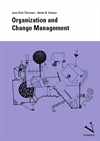Organization and Change Management
Zusammenfassung
Most introductory texts to Business Administration are wide-ranging and are always useful for every business courses and not transferable to any professional environment. This textbook introduces "Organization and Change Management" which are two dominant areas in Business Administration. The authors have developed this document for students and faculty alike, and it aims to support both the learning and teaching requirements of today. It covers the most important methods, tools and approaches and thereby provides a sound introduction to the large field of Organizational Theory. The book focuses on the following questions:
1. What is the purpose of organizing?
2. What are the possible forms of organizational structures?
3. Which approaches for change management exist?
4. Which model should be selected for the situation at hand?
- Kapitel Ausklappen | EinklappenSeiten
- 1–10 Titelei/Inhaltsverzeichnis 1–10
- 11–42 1 Fundamentals 11–42
- 1.1 Introduction
- 1.1.1 Organization as a management tool
- 1.1.2 Term “organization”
- 1.1.3 Formal and informal organization
- 1.1.4 Problem-solving process of the organization
- 1.2 Formal elements of organizations
- 1.2.1 Task
- 1.2.2 Job/unit/position
- 1.2.2.1 Terms
- 1.2.2.2 Creation of jobs/units/positions
- 1.2.2.3 Job/unit/position and workplace
- 1.2.2.4 Job/unit/position and department
- 1.2.3 Tasks, competences, and responsibility
- 1.2.4 Connecting paths or channels between jobs
- 1.3 Organizational culture
- 1.3.1 Characteristics of an organizational culture
- 1.3.2 Culture types
- 1.3.3 Effects of organizational cultures
- 1.3.4 Analysis and design of organizational culture
- 1.4 Structure and organization
- 1.4.1 Structural organization
- 1.4.2 Process organization
- 1.4.2.1 Work analysis and work synthesis
- 1.4.2.2 Objectives of the organizational structure and the dilemma of scheduling
- 1.4.3 Summary
- 1.5 Degree of specialization
- Review Questions
- 43–64 2 Organizational instruments 43–64
- 2.1 Introduction
- 2.2 Instruments for structural organization
- 2.2.1 Organigram/organizational chart
- 2.2.2 Job description
- 2.2.3 Organizational functions chart
- 2.3 Process organization instruments
- 2.3.1 Flow chart
- 2.3.2 Network diagram method and bar chart
- 2.3.2.1 Introduction
- 2.3.2.2 Structure planning: structure and presentation of network diagrams
- 2.3.2.3 Scheduling with network diagram
- 2.3.2.4 Capacity planning
- 2.3.2.5 Cost planning
- 2.4 Degree of organization
- Review Questions
- 65–94 3 Structural organization 65–94
- 3.1 Structuration principles
- 3.1.1 Principles of job formation
- 3.1.2 Management principles
- 3.1.2.1 Single-line management system (unity of command)
- 3.1.2.2 Multiple-line management system
- 3.1.3 Allocation of decision-making competences
- 3.2 Structural organizations in practice
- 3.2.1 Functional organization
- 3.2.1.1 Pure functional organization
- 3.2.1.2 Line-and-staff organization
- 3.2.2 Divisional organization
- 3.2.3 Management holding
- 3.2.3.1 Characterization and delimitation
- 3.2.3.2 Structures of a management holding
- 3.2.4 Matrix organization
- 3.2.5 Network organization and virtual organization
- 3.2.6 Project organization
- 3.2.7 Team organization
- 3.2.8 Summary
- 3.3 Primary and secondary organization
- Review Questions
- 95–102 4 Organizational structures for manufacturing 95–102
- 4.1 Workshop principle
- 4.2 Continuous production principle
- 4.3 Batch production
- 4.4 Summary
- Review Questions
- 103–120 5 Organizational change 103–120
- 5.1 Introduction
- 5.2 Basic model of organizational design
- 5.2.1 Overview
- 5.2.2 Recognizing organizational problems
- 5.2.3 Initiation and promotion of reorganization
- 5.2.4 Planning reorganization
- 5.2.5 Introduction of the organization’s chosen solution
- 5.2.6 Monitoring and further developing of the new organizational concept
- 5.3 Business reengineering as a fundamental and radical organizational change
- 5.4 Organizational development
- 5.4.1 Organizational development as evolutionary organizational change
- 5.4.2 Process of organizational change
- 5.4.3 Organizational learning
- 5.5 Comparison of the concepts change of business reengineering and organizational development
- Review questions
- 121–136 Multiple-choice questions 121–136
- Chapter 1: Basics
- Chapter 2: Organizational instruments
- Chapter 3: Structural organization
- Chapter 4: Organizational structures of manufacturing
- Chapter 5: Organizational change
- 137–138 Bibliography 137–138
- 139–140 The authors 139–140


